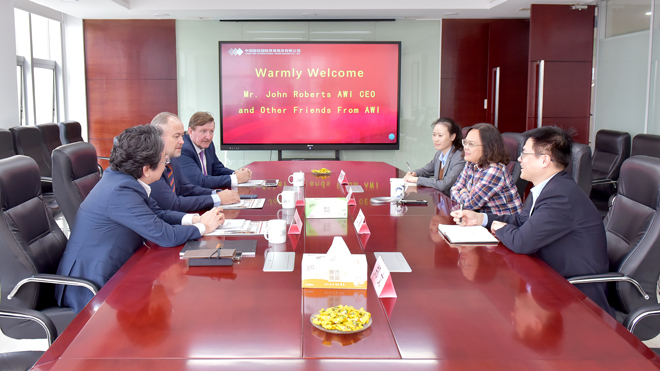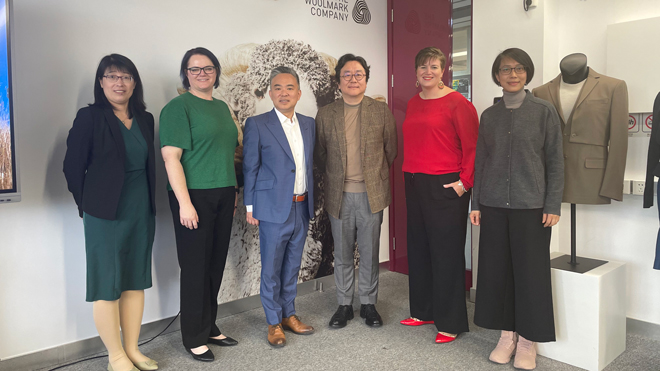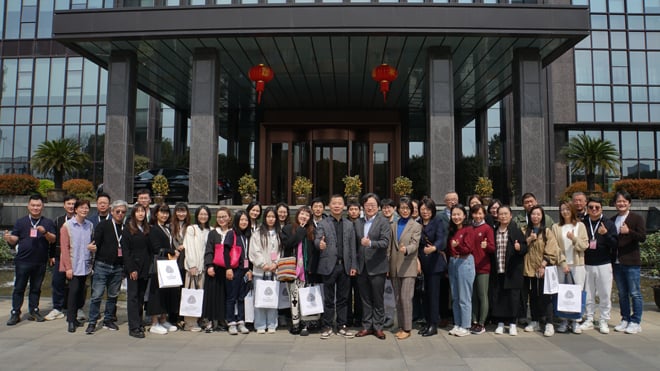China business opening up again after COVID

After three years of strict COVID pandemic control, the economic prospects for wool in China are looking up. Wool processing capacity has expanded, consumer spending on wool is forecast to increase, and face-to-face business meetings are happening once again.
AWI CEO John Roberts (left, centre), with AWI Country Manager for China Jeff Ma and AWI Trade Consultant Scott Carmody meeting in April with representatives of the Nanjing Wool Market: Ms Jiang Yali, Madam Yang and Mr Jiang Chen.
After three years of strict COVID pandemic control, the economic prospects for wool in China are looking up. Wool processing capacity has expanded, consumer spending on wool is forecast to increase, and face-to-face business meetings are happening once again.
AWI CEO’s visit to China
In April, AWI CEO John Roberts visited China for a productive week in which he met with industry groups including the China Wool Textile Association and the Nanjing Wool Market as well as with senior executives of key companies that process Australian wool. It was the first time an Australian-based representative from AWI had managed to visit China in almost four years, due to the restrictions caused by the COVID pandemic.
“Right through COVID and despite the lockdowns, the Chinese wool industry was still able to support Australian woolgrowers and the domestic trade more broadly, so it was important for me to visit China as soon as possible and thank the Chinese processing sector on behalf of our stakeholders. It was a message that the Chinese very much appreciated,” John said.
China’s wool industry expands
The first part of John’s trip involved visiting two major processing hubs, Zhangjiagang and Tongxiang, where the majority of the Australian wool clip is first processed.
“The meetings were with the biggest top makers in China. All of them reported an expansion of their processing facilities, which is really encouraging. That optimism is also reflected in many of the second-tier processors who are also looking to expand or already did so during COVID,” he said.
“Overall, the expansion in plant capacity is incredible. A few years ago, only two or three top making plants had the capacity to process more than 10 million kilos. That number has increased significantly.
“There is an underlying confidence in China and a quiet determination to expand. There is a belief that more and more Chinese consumers are going to want to wear wool, so the 50% of wool from Australia that now stays in China is going to increase each year. That’s also the view of the China Wool Textile Association.”
Increased awareness of sustainability
John says there have been major changes in both consumer and industry attitudes in China towards environmental issues.
“There has been a massive shift towards traceability and the concept of sustainability has escalated at a rate I hadn't quite expected,” he said.
“Companies haven’t expanded their factories just on a hunch, they've done their research. They understand that the Chinese consumer wants a naturally sourced fibre and they're getting a similar message from their overseas customers too, particularly with the rising spending power of Gen Z. Companies are emphasising the natural, biodegradable qualities of wool because it is a strong selling point.
“Another trend is that Chinese consumers are now increasingly buying local brands and designers, which is a massive shift from 10 to 15 years ago when it seemed everybody in China wanted the Burberry check and the Louis Vuitton imagery.”
Australian Embassy delegation visits Wool Education Centre

Nancy Zhai, Deb Langford, Li Jun, Jeff Ma, Leah Cuttriss and Junny Zhu.
In March, the Minister Counsellor–Agriculture from the Australian Embassy in Beijing, Ms Deb Langford, and her colleagues Agriculture Counsellor Ms Leah Cuttriss, and Senior Policy Officer Ms Nancy Zhai visited the Woolmark-partnered Wool Education Centre (WEC) in Donghua University, Shanghai.
They were the first guests that the WEC had welcomed since COVID-19 restrictions were lifted and were warmly greeted by The Woolmark Company’s China team and Mr Li Jun, Dean of Shanghai International College of Fashion and Innovation, Donghua University.
During the visit, AWI Country Manager for China, Jeff Ma, informed the delegation about the company’s marketing projects and strategy in China. AWI Technical Manager Junny Zhu showed them the latest Merino wool innovations, including wool uniforms for the finance industry, the OptimTM jacket, Merino seamless yoga apparel, wool velvet jacket, wool shoes and socks, and more.
The delegation had an in-depth discussion with the team about sustainability along the supply chain. Ms Langford praised the company’s marketing endeavours and spoke highly of the innovative Merino wool products she saw and believes that they bring great potential to broadening the application of Merino wool, as well as increasing consumer appeal.
The WEC, which opened in 2018, provides students with an innovative way to learn about the versatility of Australian Merino wool.
Chinese supply chain seminar and tour

36 people from 13 companies attended the event held at Xinao Textiles in collaboration with The Woolmark Company.
In March, The Woolmark Company and Chinese knitwear manufacturing giant Xinao Textiles held a seminar and tour in Zhejiang province for brand partners and independent designers.
The event started with a Merino Wool Trends and Innovation seminar, at which The Woolmark Company presented on the topics of wool consumption trends, The Wool Lab sourcing guide, wool as a sustainable and traceable fibre, and Woolmark certification – while Xinao shared their colour palettes and wool yarn trends.
There followed an on-site tour of Xinao’s wool top and yarn processing line, from raw wool, blending, scouring, carbonising and carding to top making and spinning.
There was also a visit to the Woolmark-partnered Xinao Knitwear Development Centre at which visitors were able to see the advanced knitting machines, wool swatches and garments on display. The Knitwear Development Centre comprises three main sections: a Research and Development unit, a training and education department, and fully equipped textile testing laboratories.
Through this event, brand owners explored a deeper understanding of the origins and natural benefits of wool, encouraging them to keep the fibre top of mind in their research and development and collections, in addition to considering the long-term benefits of becoming a Woolmark licensee.
This article appeared in the June 2023 edition of AWI’s Beyond the Bale magazine. Reproduction of the article is encouraged.












